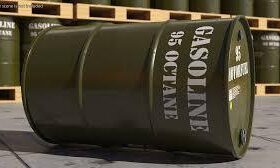Aviation fuel formerly known as “kerosene” which is suitable for most jet aircraft.
It meets stringent international requirements, particularly those of the latest versions of the AFQRJOS, the British DEF STAN 91-91 standard, the ASTM D1655 standard, and the NATO F-35 specification.
It has a minimum flashpoint of 38°C and a maximum freezing point of -47°C.
JET A-1 is the principal fuel used for jet turbine engines. It is also used in general aviation for compatible diesel engine planes. Jet fuel is a mixture of a large number of different hydrocarbons.
The range of their sizes (molecular weights or carbon numbers) is restricted by the requirements for the product, for example, the freezing point or smoke point. Kerosene-type jet fuel (including Jet A and Jet A-1) has a carbon number distribution between about 8 and 16 (carbon atoms per molecule); wide-cut or naphtha-type jet fuel (including Jet B), between about 5 and 15.
But fuelling an engine with 95 or 98 won’t necessarily open the door to earth shattering performance or extreme levels of fuel economy if the engine is not specifically designed to run on it.
Premium grade fuels simply optimize an engine’s ability to make power through increased fuel density that offer a more controlled burn, reducing engine ping (detonation) and resulting in a smoother delivery of power.
These fuels also contain detergents and boosters which keep components such as valves, pistons and combustion components free of surface varnishes and carbon build-up, which may assist in promoting a longer service life.





